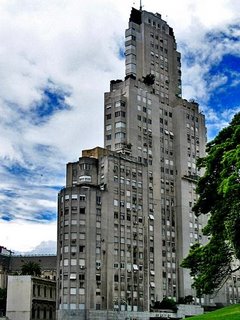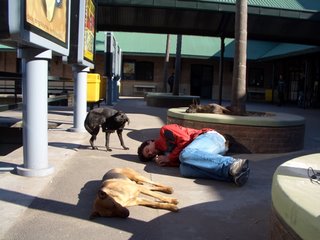Borges y yo
 Rohter says that “the Borges family's Palermo homestead still exists, at Serrano 2135, but it is not open to the public and there is nothing to mark Borges's passage there save for a small plaque.” This is a little vague. "Homestead" is a euphemism for "there is now a blah brick chalet-style dwelling where Borges's home once was." I recently saw an ad in the window of a realtor’s office – you can buy this piece of not history, apparently.
Rohter says that “the Borges family's Palermo homestead still exists, at Serrano 2135, but it is not open to the public and there is nothing to mark Borges's passage there save for a small plaque.” This is a little vague. "Homestead" is a euphemism for "there is now a blah brick chalet-style dwelling where Borges's home once was." I recently saw an ad in the window of a realtor’s office – you can buy this piece of not history, apparently.Also, a quick note on the street whose name was changed to honor Borges. Borges, in his poem “La fundación mítica de Buenos Aires” (“The Mythical Foundation of Buenos Aires”), invokes the block where he grew up:
La manzana pareja que persiste en mi barrio:
Guatemala, Serrano, Paraguay y Gurruchaga.
(The very block that persists in my neighborhood:
Guatemala, Serrano, Paraguay y Gurruchaga)
So, as my landlord Almirante pointed out, the bureaucrats who wanted to honor Borges ended up ruining his poem. Like the South Side residents in Toni Morrisons’s Song of Solomon who stubbornly refer to “Not Doctor” Street, many locals insist on calling the street Serrano.
If you’re interested in visiting a structure that Borges may actually have lived in, go to the Casa Azul (Tucumán 844), which now functions as a theater a la gorra (pay as much as you want). There are not one but TWO plaques honoring Borges’s residency there. The American equivalent to such nonsense is the “George Washington Slept Here” phenomenon.
 Rohter mentions the lovely Plaza San Martín, near where Borges spent most of his adult life. The Kavanagh is an iconic art deco skyscraper that stands at the eastern end of the plaza. Borges hated it so much that he described it as “that tall prism that dominates the estuary whose waters are the color of the desert” and a tower “that notoriously combines the detested whiteness of a sanatorium, the numbered divisibility of a prison and the general appearance of a whorehouse" in his story “La muerte y la brújula." (“Death and the Compass.”)
Rohter mentions the lovely Plaza San Martín, near where Borges spent most of his adult life. The Kavanagh is an iconic art deco skyscraper that stands at the eastern end of the plaza. Borges hated it so much that he described it as “that tall prism that dominates the estuary whose waters are the color of the desert” and a tower “that notoriously combines the detested whiteness of a sanatorium, the numbered divisibility of a prison and the general appearance of a whorehouse" in his story “La muerte y la brújula." (“Death and the Compass.”)The “Biblioteca Nacional” that Rohter mentions is no longer the Biblioteca Nacional. The current Biblioteca Nacional is an architectural monstrosity located in Recoleta, so ugly that it is worth seeing. I wonder what Borges had to say about it. (Not Rohter’s fault, but this is the library listed on the linked page).
Lastly, though Rohter talks about how Borges loved to walk through Buenos Aires, he doesn’t mention “Sentirse en muerte,” a piece in which Borges describes a stroll from Barracas to his neighborhood of Palermo. A serious walk, halfway across the city. It can be found in the collection El idioma de los argentinos. It is an itinerary this flânuer will soon follow.



3 Comments:
Nice finish to THEIR article. The person who wrote it probably never came here and used the Internet to research it. I wonder if they even knew who Borges was.
Actually, I think Larry Rohter is one of the Time's regular Latin America correspondents. It's of course impossible to say how much he missed or how much was cut in editing. Given the complex relationship of Borges and Buenos Aires, like Joyce and Dublin, it's impossible to tell it all, and to discern what's real from what’s fictitious, and determine where fiction gave birth to reality and vice versa. More than anything, I wanted to complement the article.
Hi, Brandán. Excellent post! I have to mention it on my blog... Saludos.
Post a Comment
<< Home